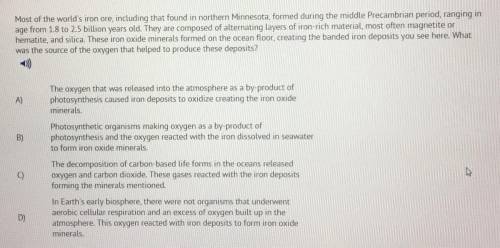
Most of the world's iron ore, including that found in northern Minnesota, formed during the middle Precambrian period, ranging in age from 1.8 to 2.5 billion years old. They are composed of alternating layers of iron-rich material, most often magnetite or hematite, and silica. These iron oxide minerals formed on the ocean floor, creating the banded iron deposits you see here. What
was the source of the oxygen that helped to produce these deposits?
A) The oxygen that was released into the atmosphere as a by-product of
photosynthesis caused iron deposits to oxidize creating the iron oxide minerals.
B) Photosynthetic organisms making oxygen as a by-product of photosynthesis and the oxygen reacted with the iron dissolved in seawater
to form iron oxide minerals.
C) The decomposition of carbon-based life forms in the oceans released oxygen and carbon dioxide. These gases reacted with the iron deposits
forming the minerals mentioned.
D) In Earth's early biosphere, there were not organisms that underwent
aerobic cellular respiration and an excess of oxygen built up in the atmosphere. This oxygen reacted with iron deposits to form iron oxide
minerals


Answers: 3


Other questions on the subject: Biology

Biology, 21.06.2019 19:00, anarosa331hotmailcom
What’s this animal (picture is tagged) and where is it most likely to live, rainforest or desert?
Answers: 1

Biology, 22.06.2019 13:20, abolton04
Imagine a self-reactive t cell that has not undergone clonal deletion in the thymus (that is to say, it has escaped central tolerance). if it encounters self antigen in the absence of an infection or inflammation, what will happen to this self-reactive t cell? (select two answers) (a) the t cell undergoes clonal expansion. (b) the t cell gains effector functions. (c) the t cell undergoes apoptosis. (d) the t cell becomes activated. (e) the t cell becomes anergic.
Answers: 1

Biology, 22.06.2019 15:30, sarbjit879
Body temperature is tightly regulated in mammals for example when external temperatures drop too much the body of a mammal response by in order to it's core temperature.
Answers: 1

Biology, 22.06.2019 15:40, TrivialRen1894
Which of these is one of the nitrogenous bases in dna? a. proline b. leucine c. glycine d. thymine
Answers: 2
You know the right answer?
Most of the world's iron ore, including that found in northern Minnesota, formed during the middle P...
Questions in other subjects:

History, 04.11.2020 19:20




History, 04.11.2020 19:20


Mathematics, 04.11.2020 19:20


Mathematics, 04.11.2020 19:20

English, 04.11.2020 19:20



